Innovation and Optimism Define DesignCon 2022
Connector companies demonstrated high-speed, high-performance systems, co-packaged optics, over-the-board cable solutions, and next-generation interconnects at an industry gathering that was nearly normal — except for its April dates.

The 27th edition of DesignCon proved to be the latest example of hope that the world is nearing a new normal post-Covid era. The masks mostly came off and attendees were able to share the latest innovation in high-speed chip and board technology in-person. An optimistic attitude was palpable at a welcome reception sponsored by Samtec Inc. and continued throughout the three-day event. Attendance levels were not quite up to previous norms, but the halls and exhibit floor remained busy even during an extensive schedule of technical presentations.
After many discussions with booth representatives, several general themes emerged.
Copper is far from dead. In some high-speed applications copper circuits may no longer be the most performance and cost-effective solution, but engineers continue to find ways to push the perceived boundaries of copper channels. Last year, the topic of many technical sessions revolved around what would be required to design successful 112 Gb/s PAM4 channels. This year many booths demonstrated multiple variations of 112 Gb/s channels over both copper and fiber. Last year the question was if 224 Gb/s copper was even possible and if it would require transition to PAM6 or higher modulation. Engineers at the conference this year expressed confidence that copper 224 Gb/s PAM4 channels are on the roadmap and will likely be demonstrated at DesignCon 2023.
We are seeing increased use of passive and active twinaxial cable in a variety of configurations. High-performance cable offers lower attenuation and better signal integrity in applications both inside and outside the box. Leading backplane connector manufacturers now provide the ability to bring discrete or ribbon twinaxial cable from the I/O panel to an area immediately adjacent to a high-bandwidth chip or module avoiding transmission through lossy PCB laminates. To support this design, connector manufacturers are introducing extremely high density and low-profile cable- to-PCB connectors that snuggle up to or mount under the heat sink of a large application-specific integrated circuit (ASIC) or module.
High-performance backplane connectors from suppliers such as Amphenol, Molex, and TE Connectivity continue to be upgraded with efforts to optimize every mm of the signal path through the connector as well as at the PCB launch. These connectors are now being rated to 112 Gb/s PAM4. High-speed PCB channels in traditional backplane architectures are being supplemented with midplane, mezzanine, and orthogonal direct designs which offer reduced signal path length. Hirose Electric, for instance, continues to upgrade its IT series of high-speed mezzanine connectors. The newest addition is the IT14, which is a BGA-attached, low-profile stacking connector rated to 56 Gb/s. Hirose also showed the IT16 mezzanine connector designed for 112G PAM4 for PCIe Gen 6 applications.
Another solution is to physically shrink all elements of the backplane to minimize the length of the channel. The ongoing trend of increased integration may allow daughtercards to become smaller. Using low-profile, high-density backplane connectors mating smaller line cards may minimize the need for advanced signal conditioning such as retimers and clock data recovery techniques improving the efficiency as well as the economics of a product.
Advanced materials used in the production of connectors and cable assemblies are expected to contribute to the ability to support next-generation interconnect requirements. Suppliers are beefing up their material science resources through in-house expansion or acquisition to identify or develop materials that can propagate signals faster while damping distortion.
The reduction of power has become a mandate for new system design. Systems built around high-speed chips are responsible for increasing rates of power consumption to unsustainable levels. This is a problem not only from cost and environmental perspectives, but the resulting heat is reaching levels where traditional air cooling is no longer effective. Unthinkable a few years ago, cold plate and immersion cooling is now being seriously considered. Designers are trying to increase performance of next-generation equipment while maintaining the current power profile.
Co-packaged optics will become a major packaging option over the next five years. This technology faces multiple technical issues, including where the laser is to be located, how fiber is attached to the chicklet, and if the chicklet should be socketed. Once resolved, a specification will be published and applications such as next-generation 102.4 Tb/s switches will likely utilize it. One recent forecast estimated co-packaged optics sales will reach $5.4 billion by 2027.
In the meantime, an MSA-driven specification for the OSFP-XD (extra density) pluggable transceiver is expected by mid-2022 and will be followed by production announcements in early 2023. This extension of the OSFP form factor adds a second row of contacts to provide 32 high-speed signal pairs, eight power, and four reserved contacts. OSFP-XD pluggables are expected to be a little longer and higher than the standard module and draw up to 40 watts. OSFP-XD is targeting 51.2+ Tb/s switch applications.
Manufacturers of simulation, Test & Measurement, and validation equipment are scrambling to introduce software and equipment in anticipation of terabit channels. Keysight recently announced a bit error rate test instrument designed to support up to 1.6 Tb applications. The extreme cost of test equipment with this capability is becoming a barrier to entry for smaller companies.
Many of these issues were the topic of over 159 well-attended technical sessions and panel discussions presented over three days.
The expo floor featured over 130 leading technology suppliers, many of which were directly related to the manufacture of connectors and or high-speed cable assemblies. A tour of the exhibit floor revealed optimism for continuing advances in both copper and fiber optic interconnect technology.
A new Amphenol Communications Solutions booth demonstrated a broad array of high-power, high-speed, high-density, and precision coaxial interconnects.
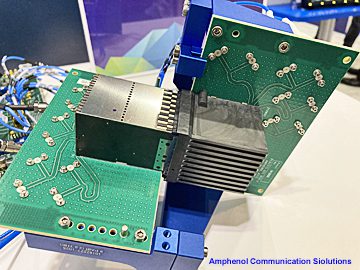
The new ExaMAX2 backplane connector was designed to support 112 Gb/s PAM4 applications.
The booth included a live demonstration of 112G PAM4 Ethernet through a pair of orthogonal direct ExaMAX2 connectors.
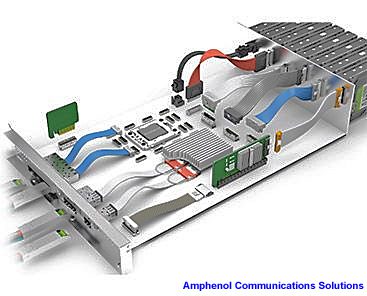
The OverPass family of internal interconnects includes the low-profile micro-LinkOVER and high-density two-piece DensiLink cable to PCB connectors.
The LEAPWIRE over-the-board interconnect from I-PEX uses the DUALINE 195-HB 112Gb PAM4 low-profile connector that fits under the heatsink of an ASIC to achieve the shortest possible signal path through PCB laminate.

Samtec displayed its growing portfolio of high-speed interconnects, including a new third-generation demonstration platform featuring the many options of 112Gb capable board-to-board and cable-to-board connectors.
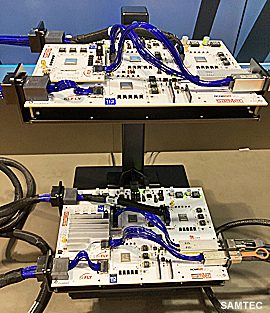
The NovaRay board-to-board and cable-to-board connectors, which offer extreme density and performance to 112 Gb/s PAM4, were prominently displayed.

Additional display panels illustrated multiple Micro Flyover™ solutions including FireFly™, AcceleRate™, and the 0.635 mm pitch AcceleRate HP connectors to address the challenge of bringing high-speed signals over the PCB and terminated adjacent to ASIC chips or modules.
The Si-Fly™ 112 Gb/s PAM4 direct cable to IC package was also on display.
Additional live displays included Flyover QSFP-DD and ExaMAX™ high-performance cable assemblies operating at 112Gb/s PAM4.

A large demonstration rack assembly featured multiple high-power distribution products from TE Connectivity. With servers drawing thousands of watts each, an efficient power distribution system becomes essential. 220V AC line power is converted to 48V DC and distributed via low loss pin and socket or blind-mate busbar connectors.
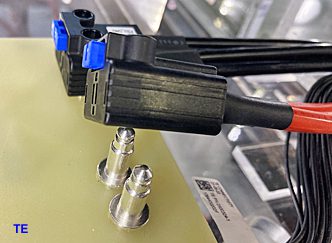
Recognizing the interest in co-packaged optics, TE showed a mock-up of a 16 chicklet ASIC module and pluggable external laser.

The model featured pluggable optical or copper interconnect using µLGA or elastomeric socket technologies with contact centerlines down to 0.4mm.
Additional live TE demonstrations included a 2.5-meter 8 X 100 Gb QSFP-DD active cable assembly using 32 AWG conductors as well as a 112 Gb/s QSFP-DD over-the-board 1.5-meter cable designed for near chip applications.
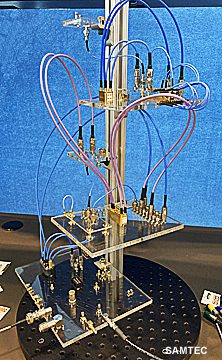
As system speeds continue to increase, demand for high-performance miniature coaxial connectors grows, especially in Test & Measurement instrument applications. Several connector manufacturers displayed lines of connectors that perform above 100 GHZ.
Southwest Microwave featured new compression-mount PCB connectors designed for 110 GHZ as well as SuperMini stacking connectors that achieve board-to-board spacing of only 3 mm.

Various configurations of co-packaged optics were on display at several vendor booths.
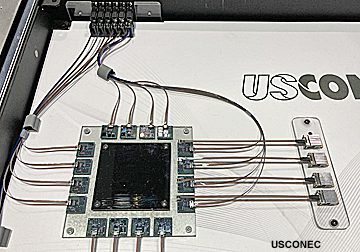 The USCONEC booth featured a version that uses a series of internal lasers and tiny Prizm LightTurn connectors on the chiplet and MXC 16 fiber expanded beam connectors on the I/O panel.
The USCONEC booth featured a version that uses a series of internal lasers and tiny Prizm LightTurn connectors on the chiplet and MXC 16 fiber expanded beam connectors on the I/O panel.
Once again, DesignCon 2022 proved to be the premier exhibition of chip and board technology providing the path to next generation copper and optical interconnects.
A digital version of DesignCon 2022 that includes new and encore content will run June 7-8, 2022.
Next year, DesignCon will return to its traditional early on January 31-February 2, 2023.
Read Bob Hult’s review of DesignCon 2021 and DesignCon 2020.
To learn more about the companies mentioned in this article, visit the Preferred Supplier pages for Amphenol Communications Solutions, Samtec, TE Connectivity.
Like this article? Check out our other board-to-board, and high-speed articles, our Datacom & Telecom Market Page, and our 2022 Article Archive.
Subscribe to our weekly e-newsletters, follow us on LinkedIn, Twitter, and Facebook, and check out our eBook archives for more applicable, expert-informed connectivity content.
- Optics Outpace Copper at OFC 2024 - April 16, 2024
- Digital Lighting Enhances your Theatrical Experience - March 5, 2024
- DesignCon 2024 in Review - February 13, 2024

